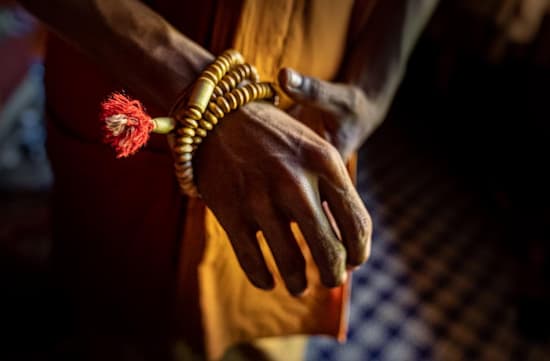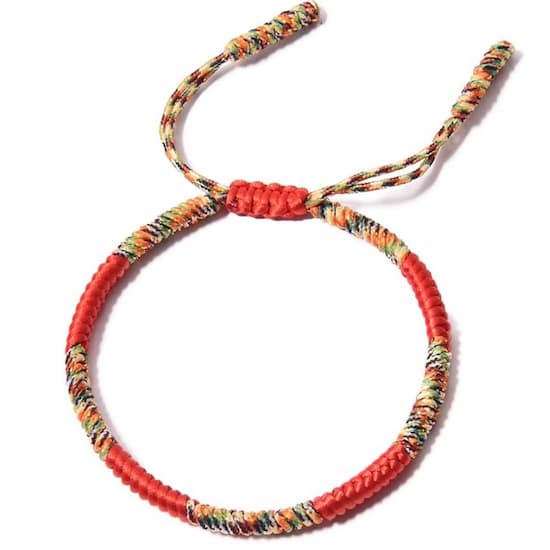In a world often hectic and chaotic, the allure of spirituality and tranquility has never been stronger. Enter the Buddha bracelet, a simple yet profound accessory that transcends fashion, offering wearers a deeper connection to ancient wisdom.
In this blog, we embark on an exploration of the meaning of Buddhist bracelets, delving into their rich history and spiritual significance. In particular, we’ll tackle what do bracelets symbolize, unveiling the hidden messages behind beads of different colors. Armed with the understanding of Buddha beads meaning bracelet, you can select the perfect Buddha bracelet to accompany you on your personal journey of spiritual growth and inner peace. Join us as we explore the Buddha bracelet meaning now!

Before diving into the Buddha beads bracelet meaning, let’s first look into what exactly the term “Buddha bracelet” denotes.
Plainly speaking, a Buddha bracelet is a spiritual accessory inspired by Buddhist traditions, designed to aid in mindfulness and inner peace.
Like regular bead bracelets, Buddha bracelets are often made of beads strung together on an elastic cord. These bracelets often feature sacred materials like wood, gemstones, or metals. Each bead symbolizes different aspects of Buddhist teachings, such as compassion, wisdom, or enlightenment. The bracelet serves as a tangible reminder to practice mindfulness and cultivate positive qualities in daily life.
In short, Buddha bracelets serve as a personal talisman, guiding individuals on their journey towards greater self-awareness and spiritual awakening.
The origins of Buddha bracelets trace back to ancient Buddhist traditions, where they were crafted as tangible manifestations of spiritual teachings.
Historically, Buddhist monks and practitioners would fashion bracelets from materials found in nature, such as wood, seeds, or stones, imbuing them with sacred significance. These early iterations served not only as adornments but also as aids to meditation and mindfulness.
Over time, as Buddhism spread across different regions and cultures, the design and materials of Buddha bracelets diversified. In Tibetan Buddhism, for instance, prayer beads known as "malas" became popular. In Southeast Asia, intricate wrist adornments adorned with symbolic charms emerged as expressions of devotion.
Today, Buddha bracelets have evolved into global symbols of spirituality and serenity. They continue to honor the timeless wisdom of Buddhist teachings while resonating with individuals seeking inner peace and enlightenment in our modern world.
Buddha bracelets, beyond their aesthetic allure, hold profound spiritual significance deeply rooted in Buddhist philosophy. Each element, from the choice of materials to the arrangement of beads, carries symbolic weight, serving as reminders of essential teachings and guiding principles.
At the core of their symbolism lies mindfulness. The act of wearing a Buddha bracelet prompts individuals to remain present in each moment, fostering a heightened awareness of their thoughts, emotions, and surroundings. Moreover, the tactile sensation of the beads against the skin serves as a gentle nudge toward mindfulness throughout the day.
Additionally, Buddha bracelets often incorporate various colors and gemstones, each imbued with specific meanings. For example, a blue bead may represent tranquility and peace, while a red one symbolizes passion and energy. By wearing these bracelets, individuals align themselves with these attributes, seeking to embody them in their daily lives.
In essence, Buddha bracelets serve as tangible manifestations of spiritual principles, guiding wearers on a journey of self-discovery, compassion, and enlightenment. They serve as constant companions, reminding individuals of the profound wisdom encapsulated in each bead, and encouraging them to live with intention and authenticity.
Buddha bracelets come in a diverse array of styles, each carrying its own unique symbolism and spiritual significance. Here we introduce some common types of Buddha bracelets:
These bracelets feature beads crafted from sacred woods such as sandalwood or rosewood. Wood holds symbolic importance in Buddhist traditions, representing grounding and connection to nature.
Gemstone Buddha bracelets incorporate beads made from various precious and semi-precious stones, each carrying its own unique properties and energies. For example, amethyst is often associated with spiritual growth and intuition, while rose quartz symbolizes love and compassion.
Mala bracelets, inspired by traditional prayer beads used in meditation, typically feature 18, 21, or 27 beads. They serve as tools for counting mantras or breaths during meditation practice, helping individuals maintain focus and mindfulness. Mala bracelets often incorporate a larger, decorative bead known as the guru bead, symbolizing gratitude and reverence for the teachings of the Buddha.
Charm bracelets combine the symbolic power of Buddha beads with additional charms representing various aspects of Buddhist philosophy. These charms may depict symbols such as the lotus flower, representing purity and enlightenment, or the Om symbol, signifying the essence of the universe.
The colors of the beads in a Buddha bracelet hold profound significance, with each hue representing a unique aspect of Buddhist philosophy and spiritual practice. By understanding the Buddhist bracelets meaning from a color perspective, wearers can align their intentions with the qualities they wish to cultivate in their lives. Below are some common colors of beads and their respective symbolic meanings:
Blue Beads: Blue beads symbolize tranquility, calmness, and serenity. They evoke the vast expanse of the sky and the tranquil depths of the ocean, reminding wearers to cultivate inner peace amidst life's challenges.
Red Beads: Red beads represent passion, energy, and vitality. They embody the fiery intensity of determination and the zest for life.
Green Beads: Green beads symbolize growth, renewal, and abundance. They mirror the lush foliage of springtime, reminding wearers of the constant cycle of growth and transformation.
White Beads: White beads signify purity, clarity, and enlightenment. They evoke the pristine brilliance of freshly fallen snow and the luminous glow of the full moon.
Black Beads: Black beads represent protection, grounding, and inner strength. They embody the deep stillness of the night and the resilient stability of the earth.

In the whirlwind of modern life, spirituality offers a sanctuary - a refuge from the chaos and noise. The humble Buddha bracelet emerges as a beacon, guiding seekers toward inner peace and enlightenment. By learning in detail about the Buddha bracelet meaning, you can select the right bracelet and embark on a transformative path towards self-discovery and serenity amidst a sea of hustle.
Buddha bracelets can be expensive due to various factors. High-quality materials like precious metals, gemstones, and rare woods contribute to their cost. Additionally, intricate craftsmanship, including hand-carving and intricate beadwork, increases their value. However, there are still hand-crafted Buddha bracelets that are both high-quality and affordable, such as the MIAM Tibetan Buddhism Bracelet.
Buddha bracelets made of durable materials like metal, stone, or certain woods can generally withstand occasional exposure to water. However, prolonged or frequent contact with water may damage certain types of beads, cause discoloration, or weaken elastic cords. As a result, it's advisable to remove Buddha bracelets before swimming, showering, or engaging in activities involving water.
In Buddhism, there isn't a strict rule regarding which hand to wear a Buddhist bracelet on. Traditionally, it's common to wear it on the left hand, which is considered the receiving hand in many cultures and symbolizes openness and receptivity to spiritual energies.
Can you sleep with a necklace on? Find out with our guide, explore its pros, cons, and the suitability of different types of materials for overnight wear.
Read MoreLearn how to fix a broken necklace chain with our guide. Follow steps for repairing herringbone, curb, box, ball, rope, and other chains, plus maintenance tips.
Read MoreLearn how to shorten a necklace with these 5 effective methods. Discover when to seek professional help and alternative solutions for excess necklace length.
Read MoreLearn how to pack necklaces in 9 effective ways to avoid tangles and damage with our guide. Discover helpful tips for moving and traveling with your jewelry.
Read More